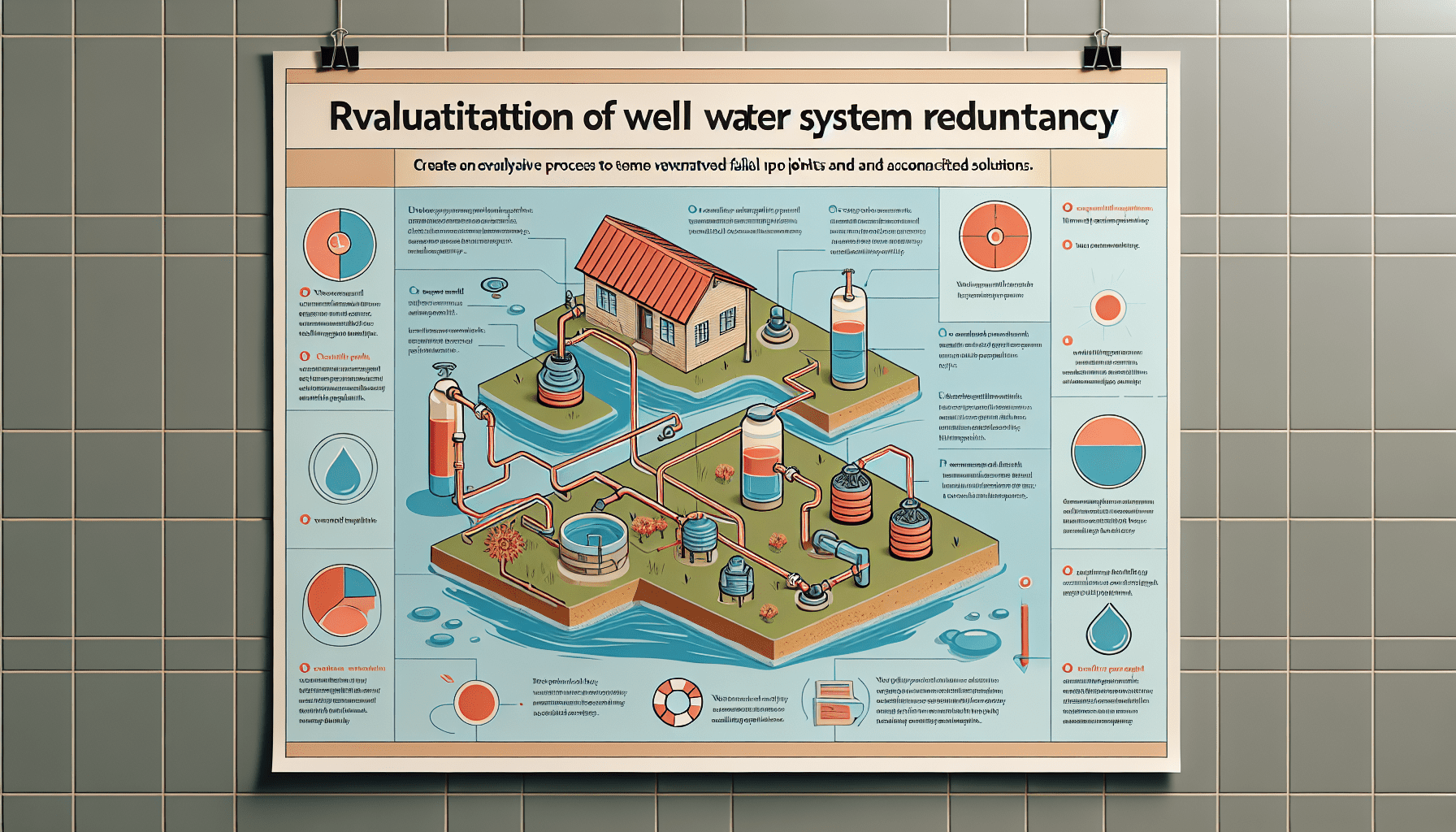If you’re a well owner concerned about the reliability of your well water system, you may be wondering if there are any resources available to help you assess its redundancy. Ensuring the availability of clean and safe water is crucial, especially when relying on a well. In this article, we will explore the available resources that can assist well owners in evaluating the redundancy of their well water systems, providing peace of mind and ensuring the continuous supply of water.
Understanding Well Water System Redundancy
What is well water system redundancy?
Well water system redundancy refers to the implementation of backup measures and alternative systems to ensure a continuous and reliable water supply from a well. It involves having multiple components and systems in place to minimize the risk of water system failure and to provide an uninterrupted water supply.
Why is well water system redundancy important?
Well water system redundancy is important for several reasons. Firstly, it helps to maintain a constant supply of water, which is essential for everyday activities such as drinking, cooking, cleaning, and irrigation. Secondly, it reduces the risks associated with water system failure, which can have detrimental effects on both personal health and property. Lastly, it provides peace of mind for well owners, knowing that they have a backup plan in place in case of emergencies.
How does well water system redundancy work?
Well water system redundancy works by incorporating backup power sources, secondary pumps, water storage solutions, water treatment redundancy, and monitoring and alarm systems. These components ensure that even in the event of a power outage, pump failure, or water contamination, an alternative system is available to provide a continuous water supply. Redundancy systems are designed to seamlessly switch to the backup components, ensuring a constant and reliable water source.
Evaluating the Need for Redundancy
Assessing the reliability of your well water system
To determine the need for redundancy in your well water system, it is vital to assess the reliability of the current system. Factors to consider include the age and condition of the well, the pump, and other components. Regular maintenance and inspections are critical to identifying any potential issues and taking corrective measures.
Identifying potential risks and failure points
Identifying potential risks and failure points is essential in evaluating the need for redundancy. Factors such as power outages, pump failures, water contamination, or natural disasters can disrupt the water supply. By understanding the vulnerabilities in the system, you can determine which redundancy options are most suitable to mitigate those risks.
Considering the impact of water system failure
Consider the impact that a water system failure would have on your daily life and property. A lack of water can be inconvenient and even hazardous, especially in emergency situations. Analyzing the potential consequences will help you gauge the necessity and urgency for implementing redundancy measures.
Determining the need for redundancy
Based on the assessments of the reliability of your well water system, potential risks and failure points, and the impact of water system failure, you can determine whether or not you need to implement redundancy measures. It is crucial to recognize that every well system is unique, and the need for redundancy may vary based on individual circumstances.

Types of Redundancy Systems
Backup power systems
Installing a backup power system, such as a generator or battery, ensures that your well pump remains operational during power outages. By automatically switching to the backup power source, you can maintain a continuous water supply regardless of electricity availability.
Secondary well pump
A secondary well pump acts as another water source if the primary pump fails. By having a secondary pump installed, you can ensure a consistent water supply. It is important to properly maintain both pumps to avoid any system failures.
Water storage solutions
Water storage solutions, such as tanks or reservoirs, can be used to store a reserve supply of water. This allows you to have access to water even if the well is temporarily unable to provide water due to maintenance, repairs, or other reasons.
Water treatment redundancy
Implementing water treatment redundancy involves having duplicate or alternative water treatment systems in place. This provides an extra layer of protection in case one system fails, ensuring that the water remains safe for consumption and use.
Monitoring and alarm systems
Monitoring and alarm systems are designed to detect any anomalies or failures in the well water system. These systems can alert you to potential issues, allowing for timely intervention and preventing potential water system failures.
Choosing the Right Redundancy Options
Understanding the pros and cons of each option
When choosing the right redundancy options for your well water system, it is crucial to understand the pros and cons of each option. Consider factors such as reliability, cost, maintenance requirements, and compatibility with your existing system. Research and consult with professionals to make an informed decision.
Evaluating the costs and budget considerations
Cost is an important factor to consider when implementing redundancy options. Evaluate the initial investment required, ongoing maintenance costs, and potential savings or benefits in the long run. It is essential to budget accordingly and determine what is feasible for your financial situation.
Consulting with professionals for expert advice
Consulting with professionals, such as well water system service providers or water treatment specialists, can provide valuable insights and expert advice. They can assess your specific needs, recommend suitable redundancy options, and guide you through the process of implementation.
Considering the specific needs of your well water system
Every well water system is unique, with different characteristics and requirements. Consider the specific needs of your well when choosing redundancy options. Factors such as water demand, depth of the well, water quality, and existing infrastructure should be taken into account to ensure compatibility and effectiveness.

Finding Resources for Assessing Well Water System Redundancy
Local and state government resources
Local and state government agencies often provide resources and information for well owners. Contact your local health department, environmental agency, or water management authority to inquire about available resources related to assessing well water system redundancy.
Well water system assessment tools
Various assessment tools and checklists are available to assist well owners in evaluating their systems. These tools typically cover areas such as well condition, pump performance, water quality, and regulatory compliance. Look for resources provided by reputable organizations or well water associations.
Online forums and communities
Online forums and communities centered around well water systems are valuable resources for gathering information and seeking advice. Engage with other well owners who have experience with redundancy systems, and learn from their insights and best practices.
Professional well water system service providers
Professional well water system service providers have the expertise and knowledge to assess well systems and recommend appropriate redundancy options. Research and contact local service providers to request assessments or consultations.
Guides and publications on well water system redundancy
Look for guides and publications on well water system redundancy. These resources often provide comprehensive information, step-by-step guidance, and case studies. Check libraries, online databases, or publications from reputable organizations to access these resources.
Benefits of Assessing Well Water System Redundancy
Improved water supply reliability
Assessing well water system redundancy and implementing appropriate measures significantly improves the reliability of your water supply. With backup systems and redundant components in place, you can trust that your water needs will be met consistently, even in unexpected situations.
Reduced risks of water system failure
By implementing redundancy measures, you significantly reduce the risks associated with water system failure. Power outages, pump malfunctions, and water contamination are common causes of system failure. Redundancy systems act as safeguards, minimizing the likelihood of such failures and their potentially damaging consequences.
Peace of mind for well owners
Knowing that you have taken proactive steps to assess and implement redundancy measures brings peace of mind. Well owners can rest assured that even in the face of challenges or emergencies, they have a reliable and secure water supply. This peace of mind translates into improved well-being and comfort for both individuals and their households.
Protection of property and assets
A reliable well water system is critical for the protection of property and assets. An inadequate or failed water supply can lead to damage, deterioration, or loss of property value. Redundancy measures ensure that water-dependent systems, such as irrigation, livestock watering, or fire protection, remain functional and safeguard your investments.

Steps for Assessing Well Water System Redundancy
Conducting a thorough inspection of the well system
Begin the assessment process by conducting a thorough inspection of your well system. This includes examining the condition of the well casing, pump, pressure tank, and other components. Look for signs of wear, leaks, or corrosion that may indicate potential failure points.
Identifying potential weak points and areas for improvement
Identify potential weak points and areas for improvement within your well system. This could involve addressing issues such as insufficient power supply, outdated or undersized pumps, or inadequate water treatment systems. Take note of these concerns as they will help guide the implementation of redundancy measures.
Researching and exploring different redundancy options
Research and explore the various redundancy options available. Take into consideration the pros and cons of each option, as well as their compatibility with your existing well water system. Look for reliable sources of information, consult with professionals, and seek recommendations or testimonials from other well owners.
Developing a comprehensive plan for implementation
Based on your assessments and research, develop a comprehensive plan for implementing redundancy measures. This plan should outline the specific actions you will take, the timeline for implementation, the budget required, and any necessary permits or approvals. Be sure to consider any local regulations or building codes that may apply.
Regular maintenance and testing of the redundancy system
Once the redundancy system is implemented, it is essential to schedule regular maintenance and testing. This includes inspecting and servicing backup power sources, secondary pumps, storage solutions, water treatment systems, and monitoring equipment. Regular maintenance ensures that the redundancy system remains functional and reliable when needed.
Budgeting and Cost Considerations
Determining the initial investment required
When budgeting for well water system redundancy, it is crucial to determine the initial investment required. This includes the costs of purchasing and installing backup power systems, secondary pumps, water storage solutions, water treatment redundancy systems, and monitoring equipment. Obtain estimates from professionals to accurately assess the financial commitment.
Calculating ongoing maintenance costs
In addition to the initial investment, consider the ongoing maintenance costs associated with the redundancy system. This includes regular inspections, servicing, and potential repairs or replacements. Factor in these recurring expenses when evaluating the long-term costs and benefits of implementing redundancy measures.
Exploring cost-effective solutions
While redundancy measures are important, it is also important to explore cost-effective solutions. Look for options that provide the necessary redundancy without unnecessary expenses. A balance between cost and functionality is crucial to ensure that the redundancy system meets your needs and remains within your budget.
Considering long-term benefits and savings
When assessing the cost considerations, consider the long-term benefits and savings that come from implementing well water system redundancy. Improved water supply reliability reduces the need for emergency water deliveries or alternative water sources, resulting in potential cost savings over time. Additionally, protecting property and assets from potential damage can save significant expenses.
Seeking financial assistance programs if available
In some cases, financial assistance programs may be available to help offset the costs of implementing well water system redundancy. Research local and state programs that support water conservation, rehabilitation, or infrastructure improvement. These programs can provide grants, loans, or tax incentives that can help make implementing redundancy more financially feasible.

Implementing Well Water System Redundancy
Hiring professional contractors for installations
When implementing well water system redundancy measures, it is advisable to hire professional contractors for installations. Well equipment installations can be complex, requiring expertise and knowledge to ensure proper functionality and compliance with building codes or regulations. Professional contractors can provide quality installations and peace of mind.
Ensuring compliance with building codes and regulations
Compliance with building codes and regulations is essential when implementing well water system redundancy measures. These regulations ensure the safety and integrity of the well system. Consult with local authorities or building departments to understand the specific requirements and guidelines that apply to your area.
Coordinating with well water service providers
Coordinate with your well water service providers when implementing redundancy measures. They can offer guidance, recommend suitable solutions, or assist with any necessary adjustments to the well system. Collaboration ensures that the redundancy measures are compatible with the existing infrastructure and do not interfere with regular maintenance or servicing.
Obtaining necessary permits
Before proceeding with the implementation of well water system redundancy measures, ensure that you obtain any necessary permits or approvals. Building codes and regulations may require specific permits for installing backup power systems, secondary pumps, or water storage solutions. Failing to obtain the necessary permits may result in penalties or legal issues.
Testing and verifying the functionality of the redundancy system
Once the redundancy system is in place, it is essential to test and verify its functionality. Ensure that backup power systems, secondary pumps, storage solutions, treatment systems, and monitoring equipment are working as intended. Conduct regular tests and inspections to confirm that the redundancy system will function effectively in the event of a water system failure.
Conclusion
In conclusion, well water system redundancy is of utmost importance for well owners. By understanding the concept of redundancy, evaluating the need for it, and choosing the right options, well owners can ensure a reliable and secure water supply. The availability of resources, such as government support, assessment tools, online forums, and professional assistance, facilitates the assessment and implementation process. Taking proactive steps to assess and implement redundancy measures brings numerous benefits, including improved water supply reliability, reduced risks of system failure, peace of mind, and protection of property and assets. By following key steps, budgets and costs considerations can be evaluated, and redundancy measures can be successfully implemented. With careful planning, coordination, and testing, well water system redundancy can be achieved, ensuring a continuous and dependable water supply for well owners.

